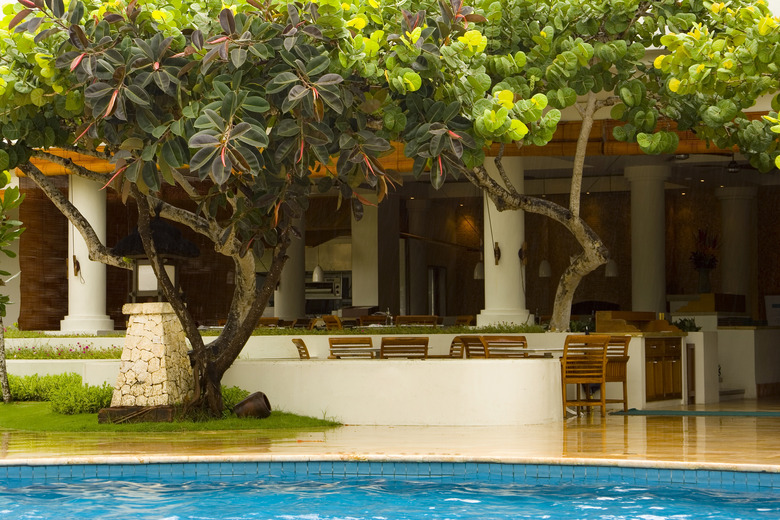How To Keep A Rubber Tree Plant Outside
Large, glossy leaves make the rubber tree (Ficus elastica) an exotic, decorative choice outdoors, but its limited hardiness makes it too delicate to just plunk in a sunny yard. It is a member of the fig family and relative of the Indian banyan tree (Ficus benghalensis). Use this distinctive plant in sheltered areas as a specimen — but be prepared to move it indoors if the temperature plummets.
Give It What It Wants
Give It What It Wants
The rubber tree plant's native environment is the still, warm, bright understory of the tropical jungle. Unless you can duplicate these gentle surroundings year-round, prepare to pamper your plant. Rubber plants potentially grow outdoors in U.S. Department of Agriculture plant hardiness zones 10 through 12, but sheltered in an enclosed patio, plants might survive in USDA zone 9. In USDA zones 9 and below, the safe bet is to pot your rubber plant in a container in a light, well-draining potting mix. Outdoors, a rubber plant tolerates most soils providing they drain well — wet soil promotes disease. Wherever your plant lives, keep the soil moist and allow it to go almost dry before watering. If you're planting in a container, choose one with at least one drainage hole.
Choose the Right Spot Outdoors
Choose the Right Spot Outdoors
Avoid western exposures for a rubber tree plant — in addition to being intolerant of freezing temperatures, it suffers when temperatures climb to 115 degrees Fahrenheit and above. Morning sun on the east side of buildings is cooler and nearby buildings are not yet reflecting or radiating the heat of the day. Plant your rubber plant near the shelter of other trees or a building, but give it plenty of room because its banyan roots are long and strong, often growing on the soil's surface. Provide shelter from breezes and drafts from air conditioner units, too. Banyans grow in USDA zones 10 through 12.
Winter Shelter for Summer Campers
Winter Shelter for Summer Campers
A rubber tree plant can survive some chilly weather — it is one of the hardiest figs — but if your area has winter snow or cold snaps when the outdoor temperature stays below 50 degrees Fahrenheit, keep your rubber plant in a container on wheels. For best results, bring your summer camper indoors before you turn on the central heating. The ideal temperature range for the big, leathery leaved plant is 60 to 65 F at night and 75 to 80 F during the day. Move the plant back outside during the day when daytime temperatures rise for a week or so before moving it outside full time.
Rubber Tree Plant Care
Rubber Tree Plant Care
Prune a young rubber plant to eliminate multiple trunks and encourage scaffold branches — branches one-half the diameter of the trunk or less that leave the trunk at about a 45-degree angle. Use a dropcloth and wear gloves when pruning to keep the milky white sap off skin and soil or pavement — it contains toxins that can cause irritation or gastric upset. Wipe the pruning tool blades with a cloth soaked in rubbing alcohol after each tree. Rubber trees need little fertilizer — a 1-inch layer of compost provides nitrogen for most trees. Slow-growing young trees benefit from monthly applications of 20-20-20 or houseplant fertilizer diluted full strength, usually 1 teaspoon in 1 gallon of water, applied instead of regular water from spring through midsummer.
References
- Missouri Botanical Garden: Ficus Elastica
- Arizona State University Extension: Ficus Elastica
- University of Hawaii Cooperative Extension Service: Ficus Plants for Hawai'i Landscapes
- University of Florida IFAS Extension: Ficus Elastica: Rubber Tree
- Clemson Cooperative Extension: Rubber Plant
- Floridata: Ficus Benghalensis
- University of California Agriculture and Natural Resources: Safe and Poisonous Garden Plants
- PharmaTutor: A Review on Biological and Phytochemical Properties of Ficus Species
